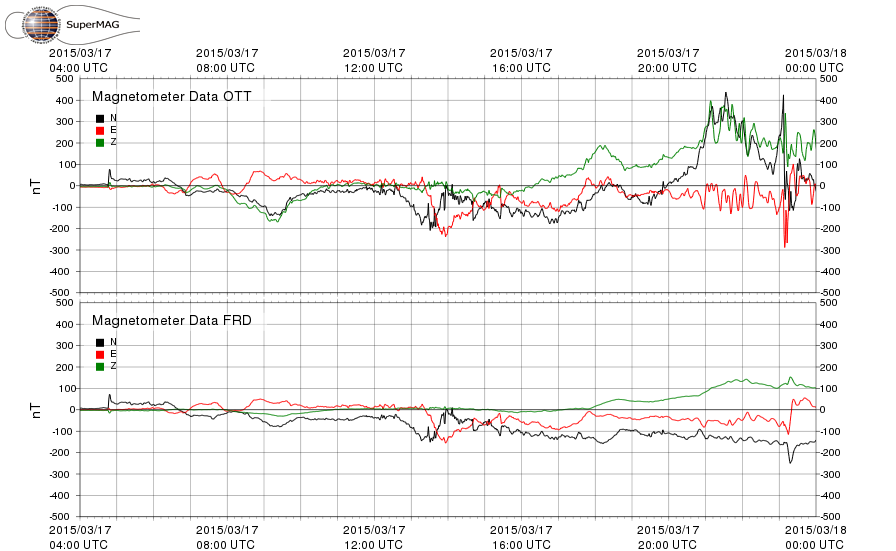Ground Magnetometer Overview
Overview
Besides auroral observations, magnetic field measurements are one of the traditional ways of observing the space weather phenomena on the ground. To that end, magnetic sensors, “magnetometer”, are typically used for space research. The instrument has a wide range of applications including metal detection, non-contact switch, non-destructive testing, oil/coal exploration, military as well as space research. Among many types of magnetometers, induction magnetometers (“fluxgate” and “search-coil”) are widely used for space applications because their designs are relatively simple and yet reliable, providing excellent performance level. For the HAMSci space weather station project, proposed is an inexpensive, simple, mid-grade magnetometer utilizing the anisotropic magneto-resistive (AMR), magneto-inductive and fluxgate technologies.
Hardware Requirement
The magnetic fields at the Earth’s surface range from 25,000 nT to 65,000 nT. Observations of absolute magnetic field values are critical in geological studies. In space research, however, only variations are of major interest. The range varies depending on the strength of the activities, from hundreds of nano-Tesla (nT) to as small as a fraction of nT. A proposed magnetometer should be able to measure the earth’s magnetic field variations associated with various geospace activities. Thus, measurements of the background magnetic fields can be ignored (oftentimes, the background fields are removed or subtracted). Figure 1 presents an example of magnetic field data from ground-based stations (top panel: Ottawa, ON; bottom panel: Fredericksburg, VA). Note that the background magnetic fields were removed in these data sets. One of the important parameters is resolution. Many science-grade magnetometers provide a fraction of nT resolution near DC. Very high-end ones can go as small as tens of pT resolution or lower. For the HAMSci space weather station project, a mid-range performance level will be targeted, adequate to measure large- and medium-scale geomagnetic activities approximately from a few to hundreds of nT. Although sub-nT measurements may be technologically achievable for this project, much more sophisticated construction, calibration and installation are required. Some of the important hardware requirements for the project are shown as follows:
- Dynamic range: full scale of the Earth’s magnetic fields (+/- 65,000 nT)
- Frequency response: DC to 5 Hz
- Time resolution: 1 sec (1 min acceptable)
- Resolution: a few nT or better over 5 Hz bandwidth (DC to 5 Hz)
- Noise: 1 nT at 1 Hz
- Digitization: 14-16 bit
- Number of sensors: three for triaxial measurements

Figure 1. Example data from ground magnetometers (top: Ottawa, ON; bottom: Fredericksburg, VA).
Possible Sensor Technology Candidates
|
Type |
Pros |
Cons |
Example Product |
|
Magneto-Resistive (MR) |
|
|
|
|
Anisotropic Magneto-Resistive (AMR) |
|
|
|
|
Magneto-Inductive (MI) |
|
|
|
|
Fluxgate |
|
|
|
Suggestion: In-House Fluxgate Magnetometer
Sensors can be built from scratch by hand (in accord very much with the “HAMScism”). The sensor consists of magnetic core material and magnet wire around it. Most of electronic components are inexpensive (can be either analog or digital). Although material/part costs are low, the project can be labor-intensive (coil winding, machining, electronics fabrication, test/calibration). Quality control can be challenging because sensors need to be accurately calibrated)
Installation/Operation Guideline
A proper installation/operation guideline is necessary to guarantee good quality data. Sensors need to be located in an electromagnetically-clean environment. For this, a passive method is typically used by placing the sensor away from any EMI sources using a cable (typically tens of meters from the station building). If there is a powerful radio transmitter around it, an aggressive low-pass filter may be necessary. A careful sensor orientation is required. Stable temperature is also highly desired (for fluxgate types, whether MR/AMR sensors are temperature-sensitive needs to be investigated). For details, go to Installation and Operation Page.
